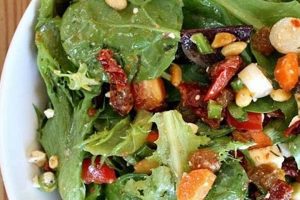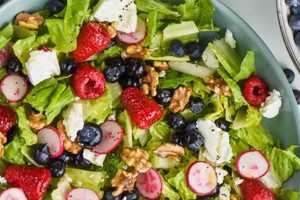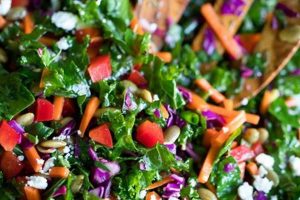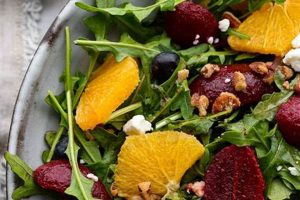Summer’s bounty is showcased in vibrant salads combining ripe tomatoes and sweet peaches. These dishes offer a refreshing contrast of flavors and textures, featuring the acidity of tomatoes alongside the soft sweetness of peaches. Variations often include cheeses such as mozzarella or burrata, herbs like basil or mint, and a simple vinaigrette. For instance, a classic preparation might involve sliced tomatoes and peaches, fresh mozzarella, basil leaves, and a balsamic glaze.
The pairing of these two fruits provides a nutritional boost with vitamins, minerals, and antioxidants. Historically, such combinations likely arose from the coinciding harvest seasons of both fruits, allowing cooks to create innovative dishes using readily available produce. This culinary approach highlights seasonal eating and reduces reliance on ingredients transported long distances. The refreshing nature of these salads makes them ideal for warm weather meals or light lunches.
Further exploration will delve into specific recipe variations, including those suitable for vegan and vegetarian diets, as well as variations showcasing different regional culinary influences. The discussion will also cover ingredient selection, preparation techniques, and presentation suggestions for visually appealing and flavorful results.
Tips for Crafting Exceptional Tomato and Peach Salads
Creating a harmonious balance of flavors and textures is key to a successful tomato and peach salad. The following tips offer guidance for achieving optimal results.
Tip 1: Select Ripe, High-Quality Produce. Flavor is paramount. Choose tomatoes and peaches at peak ripeness for the sweetest, most flavorful salad. Look for fragrant peaches with a slight give and richly colored tomatoes.
Tip 2: Balance Sweetness and Acidity. The interplay of sweet and tart flavors is essential. If peaches are exceptionally sweet, consider using slightly less ripe, more acidic tomatoes. A squeeze of lime juice can also enhance the balance.
Tip 3: Consider Complementary Ingredients. Enhance the salad with ingredients that complement both tomatoes and peaches. Fresh mozzarella, burrata, goat cheese, or feta offer creamy counterpoints. Fresh herbs like basil, mint, or tarragon add aromatic complexity.
Tip 4: Experiment with Textures. Toasted nuts or seeds (such as pecans, walnuts, or sunflower seeds) provide a satisfying crunch. Crumbled bacon or prosciutto can add a salty, savory element.
Tip 5: Dress Lightly. A simple vinaigrette is often the best choice. A light balsamic glaze, a lemon-herb vinaigrette, or a drizzle of high-quality olive oil can enhance the natural flavors without overpowering them.
Tip 6: Serve Immediately. For optimal texture and flavor, assemble and serve the salad just before consumption. This prevents the fruit from becoming soggy and maintains the crispness of any added greens.
Tip 7: Season Judiciously. A pinch of salt and freshly ground black pepper can elevate the overall flavor profile. Taste and adjust seasonings as needed before serving.
By following these tips, one can create flavorful and visually appealing salads that highlight the delicious combination of tomatoes and peaches.
The provided guidance establishes a foundation for crafting delightful summer salads, paving the way for further culinary exploration and personalized variations.
1. Ripe Ingredients
The foundation of any successful tomato peach salad rests upon the quality of its core components: ripe tomatoes and peaches. Ingredient ripeness directly influences the flavor profile, texture, and overall enjoyment of the final dish. Selecting produce at its peak ensures optimal sweetness, juiciness, and aromatic complexity.
- Peak Season Produce
Peak season tomatoes and peaches offer the most intense flavor. Locally sourced, in-season produce minimizes transportation time, maximizing freshness and nutritional value. Out-of-season fruits often lack the desired sweetness and complexity, potentially compromising the salad’s overall balance.
- Indicators of Ripeness
Recognizing ripeness is crucial. Ripe peaches yield slightly to gentle pressure and emit a fragrant aroma. Tomatoes should be vibrantly colored with smooth skin and a slight give. Avoiding overly firm or bruised specimens ensures optimal texture and taste. A deep red hue often indicates a richer flavor profile in tomatoes.
- Flavor Development
Ripeness dictates the balance of sweetness and acidity. Fully ripe peaches provide a burst of sweetness balanced by the subtle tartness of ripe tomatoes. This interplay is essential for a harmonious flavor profile. Underripe fruit can introduce unwanted tartness or astringency, disrupting the intended balance.
- Textural Integrity
Ripe, yet firm, tomatoes and peaches hold their shape when sliced, contributing to a pleasing salad texture. Overripe fruit can become mushy, compromising the visual appeal and structural integrity of the dish. Maintaining textural contrast between the fruits and other salad components, such as cheese or nuts, is key for a satisfying culinary experience.
Utilizing ripe ingredients elevates the tomato peach salad from a simple combination of ingredients to a celebration of summer flavors. The selection of peak-season produce ensures a vibrant and flavorful dish, showcasing the natural sweetness and complexity of these two quintessential summer fruits.
2. Balanced Flavors
Balanced flavors are essential for a successful tomato peach salad. The inherent sweetness of ripe peaches requires a counterpoint, preventing the salad from becoming cloying. This balance is achieved through the strategic incorporation of acidic, savory, and herbaceous elements, resulting in a harmonious flavor profile.
- Acidity
Acidity plays a crucial role in cutting through the sweetness of the peaches. Tomatoes, especially heirloom varieties, contribute inherent acidity. A vinaigrette, often incorporating lemon juice or vinegar, further enhances this tartness. The interplay between sweet and tart flavors creates a dynamic and refreshing taste experience. For example, a balsamic vinaigrette provides a deeper, more complex acidity compared to a simple lemon vinaigrette.
- Savory Notes
Incorporating savory elements adds depth and complexity, preventing the salad from being one-dimensional. Salty cheeses like feta or Parmesan provide a contrasting savory note. Additions like prosciutto or toasted nuts introduce subtle savory nuances. The presence of savory elements enhances the overall balance, complementing both the sweetness of the peaches and the acidity of the tomatoes and dressing. Crumbled bacon, for instance, offers a smoky, salty counterpoint to the sweetness of the peaches.
- Herbaceous Aromas
Fresh herbs introduce aromatic complexity and contribute to a more nuanced flavor profile. Basil, mint, and tarragon are classic pairings with both tomatoes and peaches. The herbs’ aromatic oils enhance the overall sensory experience, adding layers of flavor beyond simple sweet and tart. Mint, for example, provides a refreshing coolness that complements the sweetness of the peaches, while basil adds a peppery, slightly anise-like flavor.
- Umami
While less prominent than acidity or savory notes, a touch of umami can further elevate the salad’s flavor profile. A sprinkle of Parmesan cheese or the inclusion of a few olives can introduce this savory depth. Umami adds a subtle richness and complexity, rounding out the overall taste experience without overpowering the delicate balance of sweet, tart, and herbaceous flavors. A small amount of crumbled blue cheese, while also adding a salty element, can provide a subtle umami note that enhances the overall complexity of the salad.
The interplay of these elementsacidity, savory notes, herbaceous aromas, and umamicreates a well-rounded and satisfying flavor profile. Careful consideration of these components ensures that the inherent sweetness of the peaches is balanced by contrasting flavors, resulting in a complex and refreshing tomato peach salad that appeals to a wide range of palates. The balance achieved not only enhances the individual flavors but also creates a synergistic effect where the whole is greater than the sum of its parts.
3. Complementary Pairings
Complementary pairings elevate tomato peach salads from simple to sophisticated. These pairings enhance the inherent flavors of the core ingredientsripe tomatoes and sweet peachesby introducing contrasting textures, aromas, and tastes. Careful consideration of these pairings ensures a balanced and nuanced flavor profile, crucial for a truly exceptional salad.
The sweetness of peaches and acidity of tomatoes provide a foundational flavor contrast. Complementary pairings amplify this contrast while adding further complexity. Creamy cheeses, such as fresh mozzarella, burrata, or goat cheese, offer a textural counterpoint to the softness of the peaches and the slight firmness of the tomatoes. Their mild, milky flavors harmonize with the sweetness of the fruit while also providing a subtle tang that balances the overall profile. Fresh herbs, like basil, mint, or tarragon, contribute aromatic complexity and enhance the salad’s freshness. Basil’s peppery notes and mint’s cooling sensation complement both fruits, while tarragon adds a subtle anise-like flavor that further elevates the complexity of the dish. The interplay of creamy, herbaceous, sweet, and tart elements creates a multi-layered sensory experience.
For example, a tomato peach salad with fresh mozzarella, basil, and a balsamic glaze exemplifies successful complementary pairings. The creamy mozzarella contrasts with the juicy fruits, the basil adds a fresh, peppery aroma, and the balsamic glaze provides a tangy sweetness that complements the peaches. Another example involves feta cheese, mint, and a lemon vinaigrette; the salty feta and refreshing mint balance the sweetness of the peaches, while the lemon vinaigrette enhances the tomatoes’ acidity. These examples demonstrate how strategic pairings amplify existing flavors and contribute new dimensions, resulting in a more complex and satisfying culinary experience. Understanding the interplay of these flavors allows for informed ingredient choices, ultimately leading to more balanced and delicious tomato peach salads.
4. Textural Variation
Textural variation is crucial for a compelling tomato peach salad. The inherent softness of ripe peaches and the yielding texture of tomatoes benefit from contrasting elements. These textural additions create a more engaging and satisfying culinary experience. A salad solely comprised of soft ingredients can feel monotonous, while the introduction of contrasting textures provides a dynamic interplay that elevates the dish beyond simple flavor combinations. This interplay stimulates multiple sensory receptors, resulting in a more complete and enjoyable dining experience.
Several ingredients can contribute textural contrast. Toasted nuts, such as pecans, walnuts, or almonds, offer a satisfying crunch and nutty flavor that complements the sweetness of the peaches. Seeds, like sunflower or pumpkin seeds, provide a similar textural element and subtle earthy notes. Crumbled bacon or prosciutto introduce a crisp, salty counterpoint to the soft fruits. Even the choice of cheese can influence texture; a firm feta offers a different experience than a creamy burrata. The interplay of these texturessoft, crunchy, creamy, crispcreates a dynamic and engaging mouthfeel. For example, a salad featuring ripe peaches, sliced tomatoes, toasted pecans, crumbled feta, and fresh basil offers a delightful combination of soft, crunchy, and creamy textures, enhancing the overall enjoyment of the salad.
Understanding the importance of textural variation enables the creation of more complex and satisfying tomato peach salads. It allows for a conscious manipulation of texture to achieve a balanced and engaging culinary experience. By incorporating ingredients that offer contrasting textures, one transforms a simple combination of fruits into a multi-dimensional dish that stimulates the palate and elevates the sensory experience. This principle of textural variation applies not only to tomato peach salads but also to a wide range of culinary creations, highlighting its universal importance in achieving gastronomic excellence.
5. Appropriate Dressings
Appropriate dressings play a critical role in tomato peach salad recipes, acting as a unifying element that harmonizes the diverse flavors and textures. The dressing should complement, not overpower, the delicate sweetness of ripe peaches and the subtle acidity of tomatoes. An overly heavy or intensely flavored dressing can mask the natural flavors of the produce, while a well-chosen dressing enhances and elevates the overall taste experience. The viscosity, acidity, and flavor profile of the dressing must be carefully considered in relation to the other salad components.
Light, vinaigrette-style dressings often prove ideal for tomato peach salads. A simple balsamic vinaigrette, with its tangy sweetness, complements both the peaches and tomatoes. A lemon-herb vinaigrette, featuring fresh herbs like basil or mint, adds brightness and aromatic complexity. A drizzle of high-quality extra virgin olive oil, combined with a pinch of salt and freshly ground black pepper, provides a minimalist approach that allows the natural flavors of the produce to shine. Conversely, creamy dressings, such as ranch or blue cheese, typically do not pair well with this type of salad, as their richness can overwhelm the delicate flavors of the fruits. Consider the intensity of other ingredients; a salad with strong cheeses or cured meats might benefit from a lighter dressing, while a simpler salad might accommodate a slightly more assertive vinaigrette.
The choice of dressing directly impacts the overall balance and enjoyment of a tomato peach salad. A well-chosen dressing enhances the natural sweetness and acidity of the fruits, creating a harmonious flavor profile. Conversely, an inappropriate dressing can detract from the delicate flavors, resulting in a less satisfying culinary experience. Careful consideration of the dressing’s acidity, flavor intensity, and viscosity ensures that it complements rather than competes with the other salad components, resulting in a well-balanced and delicious dish.
6. Seasonal Relevance
Seasonal relevance is paramount in “tomato peach salad recipes,” directly impacting flavor, quality, and overall culinary experience. Peak season produce offers superior taste and nutritional value compared to out-of-season alternatives. Exploring this connection reveals the importance of aligning culinary practices with nature’s rhythms for optimal results.
- Peak Flavor and Quality
Tomatoes and peaches reach peak flavor and nutritional value during their respective growing seasons. Summer’s warmth and abundant sunshine allow these fruits to develop full sweetness and complex aromas. Out-of-season produce, often transported long distances, may lack the same vibrancy and depth of flavor due to premature harvesting and artificial ripening methods. A tomato peach salad crafted with peak-season ingredients showcases the fruits’ inherent sweetness and juiciness, resulting in a superior culinary experience.
- Local Sourcing and Sustainability
Seasonal relevance encourages local sourcing, reducing transportation costs and environmental impact. Consuming locally grown, seasonal produce supports local farmers and reduces reliance on resource-intensive shipping practices. Farmers’ markets and local farms offer access to freshly harvested tomatoes and peaches, ensuring peak flavor and minimizing the carbon footprint associated with food transportation. This alignment with local ecosystems contributes to a more sustainable food system.
- Enhanced Nutritional Value
Produce consumed during its peak season often boasts higher nutritional content. Fruits and vegetables allowed to ripen fully on the vine or tree accumulate a greater concentration of vitamins, minerals, and antioxidants. These nutrients contribute to overall health and well-being. A tomato peach salad made with in-season produce provides a richer source of these beneficial nutrients compared to a salad made with out-of-season counterparts.
- Culinary Inspiration and Creativity
Seasonal relevance inspires culinary creativity by encouraging the use of fresh, readily available ingredients. The limited availability of specific produce during certain times of the year challenges cooks to develop innovative recipes that highlight seasonal flavors. This focus on seasonality fosters a deeper appreciation for the natural world and its rhythms, influencing culinary practices and driving innovation in the kitchen. The tomato peach salad, a quintessential summer dish, exemplifies this connection between seasonal ingredients and culinary expression.
The connection between seasonal relevance and tomato peach salad recipes underscores the importance of aligning culinary practices with the natural world. Prioritizing in-season produce elevates flavor, supports local economies, reduces environmental impact, and enhances nutritional value. This holistic approach to food preparation results in a more satisfying and sustainable culinary experience, demonstrating the interconnectedness between nature’s rhythms and culinary excellence.
7. Presentation
Presentation elevates tomato peach salad recipes from simple meals to visually appealing culinary creations. Thoughtful presentation enhances the dining experience, engaging multiple senses and increasing perceived value. While flavor remains paramount, visual appeal significantly contributes to overall enjoyment. This exploration delves into key facets of presentation, demonstrating how they transform a basic salad into a captivating dish.
- Color and Contrast
Vibrant colors stimulate appetite and create visual interest. The natural hues of ripe tomatoes and peaches provide an excellent foundation. Incorporating contrasting colors through ingredients like deep green basil, bright purple onions, or creamy white cheese amplifies visual appeal. Consider the color wheel for harmonious pairings; green complements red and orange, while purple contrasts beautifully with the peachy hues. A sprinkle of black pepper adds visual punctuation.
- Arrangement and Composition
Strategic arrangement transforms ingredients into an aesthetically pleasing composition. Avoid simply tossing ingredients together; instead, consider layering or arranging elements thoughtfully. Sliced peaches fanned around a mound of fresh mozzarella, interspersed with tomato wedges and basil leaves, creates a more visually engaging presentation than a haphazard mix. Height variation adds dimension and visual interest.
- Serving Vessels and Plating
The choice of serving vessel influences perception. A rustic wooden bowl evokes a different feeling than a sleek white plate. Consider the overall aesthetic and choose a vessel that complements the salad’s composition. Individual plating allows for greater control over presentation, while family-style serving encourages sharing and a more communal dining experience.
- Garnishes and Finishing Touches
Garnishes provide final flourishes that enhance visual appeal and add subtle flavor nuances. A drizzle of balsamic glaze, a sprinkle of toasted nuts, or a scattering of edible flowers adds a touch of elegance. These finishing touches signal attention to detail and elevate the perceived value of the dish. However, garnishes should be used judiciously and complement the existing flavors, not overpower them.
Consideration of these presentational aspects elevates tomato peach salad recipes. Visual appeal enhances the dining experience, transforming a simple salad into a visually captivating and more enjoyable culinary creation. The interplay of color, arrangement, serving vessel, and garnishes creates a multi-sensory experience that amplifies the inherent flavors and textures of the dish, demonstrating the significant impact of presentation on overall culinary appreciation.
Frequently Asked Questions
This section addresses common inquiries regarding tomato and peach salad preparation, offering practical guidance for achieving optimal results.
Question 1: How can one prevent the peaches from browning in the salad?
Tossing sliced peaches with a small amount of lemon juice or ascorbic acid (vitamin C powder) inhibits enzymatic browning, preserving their vibrant color and appearance.
Question 2: What are the best tomato varieties for this type of salad?
Heirloom tomatoes, known for their diverse colors and flavor profiles, offer excellent options. Consider Brandywine, Cherokee Purple, or Green Zebra tomatoes for unique flavor dimensions. Ripe Roma tomatoes, with their lower water content, also work well.
Question 3: Can other fruits be incorporated into a tomato and peach salad?
While the focus remains on tomatoes and peaches, complementary fruits like watermelon, cantaloupe, or berries can be added in moderation. Ensure the added fruits share similar flavor profiles and textures to maintain balance.
Question 4: What are suitable vegan alternatives for cheese in these salads?
Vegan cheeses, such as cashew-based mozzarella or almond-based feta, offer alternatives. Avocado, with its creamy texture, can also provide a similar textural element and healthy fats.
Question 5: How long can a tomato peach salad be stored in the refrigerator?
While best consumed immediately, leftover salad can be stored in an airtight container in the refrigerator for up to 24 hours. However, some textural changes may occur. It is recommended to dress the salad just before serving to maintain optimal texture.
Question 6: Can this salad be served as a side dish or part of a larger meal?
Tomato peach salad complements grilled meats, fish, or poultry. It can also serve as a refreshing appetizer or a light lunch. Its versatility allows for adaptation to various meal structures.
Careful ingredient selection and preparation techniques ensure optimal results when creating a tomato and peach salad. Addressing these common inquiries provides a foundation for culinary success.
The provided information equips readers with the knowledge to create flavorful and visually appealing tomato and peach salads, paving the way for culinary experimentation and enjoyment.
Tomato Peach Salad Recipes
Exploration of tomato peach salad recipes reveals the potential for culinary innovation using seasonal ingredients. Emphasis on ripe produce selection, balanced flavor profiles, complementary pairings, textural variation, appropriate dressings, and thoughtful presentation elevates these salads beyond simple combinations. The interplay of sweet peaches and tart tomatoes, enhanced by carefully chosen additions, creates a vibrant and refreshing dish. Nutritional value, derived from fresh, seasonal produce, further underscores the benefits of this culinary approach.
Tomato peach salad recipes exemplify the potential of seasonal cuisine to deliver both flavor and aesthetic appeal. Continued exploration of such combinations promotes culinary creativity and encourages appreciation for the natural rhythms of food production. This approach fosters a deeper connection between culinary practices and the availability of fresh, locally sourced ingredients, ultimately enriching the dining experience.






